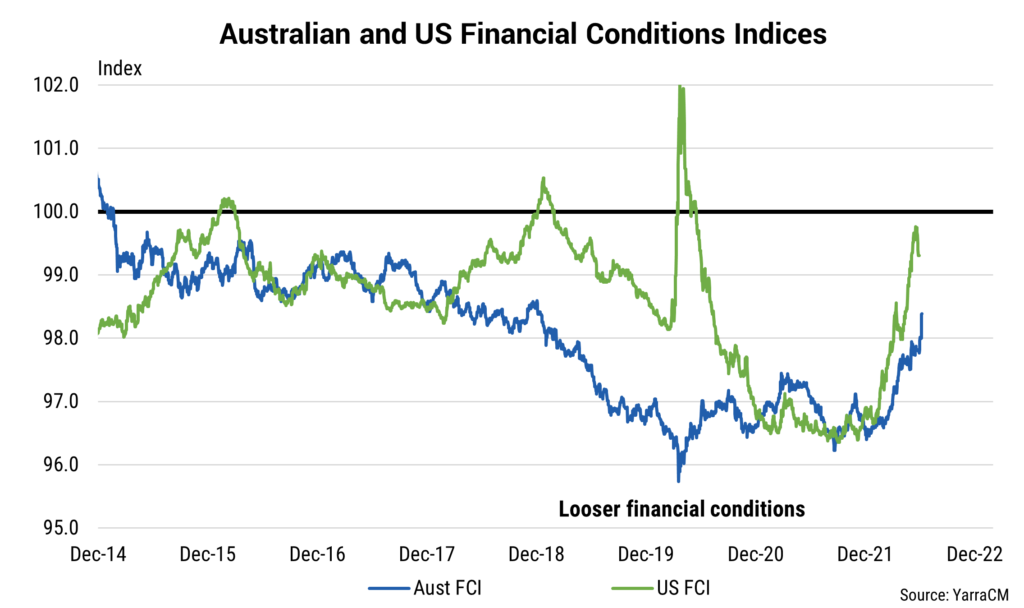The RBA hikes interest rates by 50 bps and now appears to be playing catch-up after failing to detect the inflation threat early enough.
A 50 basis point hike by the Reserve Bank of Australia (RBA) was clearly a surprise for financial markets. The RBA’s rationale for increasing interest rates was that inflation is higher than expected. This is despite the fact that the CPI data was printed ahead of the May decision (i.e. the inflation surprise is not “new” news) and despite the RBA’s acknowledgement that the prime reason for high inflation is due to supply shortages rather than excess demand. The RBA nevertheless decided to go against its own guidance that 25bps hikes could be expected going forward as part of their self-selected ‘business as usual’ strategy, instead delivering a 50bp hike.
Indeed, the economic data since the May decision can be best described as limited and the tone of the data clearly missed to the downside, rather than exceeded expectations. Business confidence eased, consumer confidence was sharply lower, the wage price index missed expectations to the downside, employment was 25k weaker than expected, building approvals was 4.4% weaker than expected and home loans written were 6% below expectations. Only the GDP data slightly beat expectations (0.8%qoq v 0.7% expected).
The only other data that the RBA likely could have looked at was the monthly Inflation Gauge data that did come in relatively strong at the start of the week. Again, however, the reason for the strength was supply side issues in petrol, energy, food and rent. It is also relevant to note that the accuracy of this survey can be questionable.
The RBA’s inability to read the (financial market) room was again on full display. While only slightly more surveyed economists expected 25bps than a larger move, only 3 of the 29 surveyed expected a 50bp hike. The ASX200 fell 0.6% and 3-year bond yields spiked 12bps as a consequence of yet again opaque and arguably misleading communication.
Arguably, this is clearly an attempt of catch-up by a central bank that has been caught out by failing to detect the inflation threat early enough and now, in an effort to make greater inroads into the negative real cash rate settings, has chosen to surprise financial markets. There is likely an element of using the cover of larger hikes from the US, BoC and RBNZ to hike by a greater increment in June. However, in choosing this action the RBA has opened the door to implementing further 50bp hikes in coming months. It is indeed possible that inflation prints high in Q2, and the RBA mechanically follows with a 50bp hike in August.
For households and firms this inconsistency in terms of communication, data flow and action likely adds a layer of confusion into financial markets at a time when forward looking and consistent guidance is needed.
The RBA has indicated that it sees further hikes necessary stating it “expect[s] to take further steps in the process of normalising monetary conditions in Australia over the months ahead”. However, if “the size and timing of future interest rate increases will be guided by the incoming data and the Board’s assessment of the outlook for inflation and the labour market” then it would be useful if they were consistent in that interpretation of that data and their decision on the cash rate.
From our perspective it was a coin toss between a 25bp or 40bp hike. However, rates markets are now left with little choice but to embed hikes in excess of 25bps per meeting for the next few months while the RBA moves to set local rates sharply higher in an effort to contain global supply led inflation pressures.
In the rush to catch up to other central banks, however, we need to be conscious that the monetary transmission mechanism works very differently in Australia. The tightening in financial conditions in the US has been a function of all key forces moving in the same direction (wider corporate bond spreads, higher bond yields, higher USD, weaker US equities and Fed hikes). In Australia, however, movements in the RBA cash rate and the A$ have much greater impacts.
Australia’s financial conditions have now tightened materially post the RBA’s decision (refer chart). Should the RBA hike rates by a further 100bps over the coming months, Australia’s financial conditions will likely move closer to the current level in the US. However, given Australia is currently already a high carry currency, the risk is now firmly skewed to a materially higher A$ in coming months. The impact of this would likely be to further tighten Australian financial conditions and act as a material headwind for the interest rate sectors of housing and consumer discretionary.


0 Comments